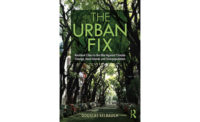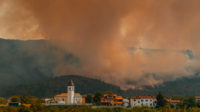James Russell argues in this well-researched and persuasive book that cities will need to become agile: to adapt to the climate changes already in progress and to reduce the potential for a global environmental catastrophe as the world races towards a population of more than 10 billion.
Transitioning to energy-efficient buildings is one form of agility open to all cities. Adopting planning measures that preserve more of the natural environment, supported by diverse forms of transportation and not just highways, is another strategy within the control of state and local governments. Designing buildings and districts that can adapt to rising sea levels and more frequent floods is also possible locally. None of these measures depends on international accords limiting or trading emissions, and all of them if scaled up to general practice would have a big impact worldwide in reducing pollutants and protecting existing cities.
Russell, the architecture columnist for Bloomberg News and previously an editor of Architectural Record, is specific about real examples that he has visited himself.
His descriptions of energy–efficient buildings at a variety of scales include Kroon Hall at Yale University (by Hopkins Architects and Centerbrook), which reduces its potential carbon footprint by 62.5 percent. Another example is the Dockside Green residential development in Vancouver (by Busby Perkins+Will) which cuts its energy needs by more than 50 percent. The Omega Center for Sustainable Living in Rhinebeck, New York (by BNIM Architects) will ultimately meet its water supply and disposal needs entirely within its 195-acre site. The San Francisco Federal Building (by Morphosis) operates mostly with natural ventilation and day lighting. Endesa Headquarters in Madrid (by KPF, Rafael de La-Hoz, Battle McCarthy) radically reduces its summer cooling needs through natural ventilation. All of these low-impact examples go well beyond what is typically expected of LEED-rated buildings, moving them towards the ideal of zero-footprint operation.
Looking at planning efforts, Russell describes growth boundaries established in Seattle and Portland and shows examples of alternative transportation, like a five-story parking garage for bicycles in Amsterdam and green streets in Bilbao that accommodate pedestrians, bicycles, transit, cars and deliveries in a landscaped environment. He also examines how designers are weaving construction and nature together. For example, he visits a huge artificial dune in Scheveningen, the Netherlands, that protects shore communities from flood surges, and the Ijberg quarter in Amsterdam that integrates itself with wetlands absorbing and slowing down floodwaters. At the HafenCity development in Hamburg, he explains how the buildings are elevated above flood plains of the Rhine River, while their protection is concealed within parks and esplanades.
All these examples support Russell’s argument that the techniques for creating more agile cities are already in successful use; they need only be adopted more generally to have a major impact. Here in the United States, we face a number of impediments to such sensible strategies. Russell cites the commodification of the real-estate industry, which has settled on a limited range of products—such as strip shopping centers and walk-up apartments surrounded by parking lots—and repeats them within a financial system that resists innovation. The ubiquity of standard real-estate products reflects established development regulations and highway policies that promote low-density growth. Another problem is resistance to accepting the reality of climate change.
Russell finds answers, though, in the potentially favorable economics of actions that limit energy consumption, promote more compact development, and use physical protection against disasters instead of relying solely on insurance policies. He also says the mortgage interest tax deduction, which supports current unsustainable growth, needs to go, along with current transportation policies that favor highways over transit, bicycle paths, and sidewalks. These changes will be a tough sell politically, but Russell posits that the economics of conservation plus persuasive alternative visions of city development can eventually win out.
The Agile City is a valuable addition to the discussion of livability in cities, the preservation of the natural landscape, and the protection of the global environment.
Jonathan Barnett is a professor of city and regional planning and director of the Urban Design Program at the University of Pennsylvania, as well as the author of the recently published City Design: Modernist, Traditional, Green, and Systems Perspectives.




Post a comment to this article
Report Abusive Comment